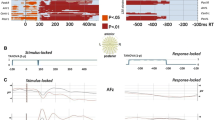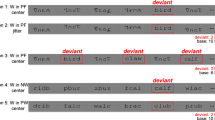Abstract
Periods of stable global electric field at scalp unfolding during a cognitive task can be linked to brain processes and are therefore well suited to investigate simultaneously qualitative and quantitative differences across conditions or populations of interest. The electrophysiological event-related (ERP) spatio-temporal dynamic has been repetitively investigated in referential word production, but the different designs, settings and analyses do not allow to conclude on the reliability of the microstate sequences across studies and individuals. Here the inter-studies and inter-individual consistency of sequences of scalp topographies were analysed in the ERP data of 118 individuals from five different oral picture naming studies. Averaging the individual ERP data across studies or across random groups yielded the same sequences of microstates, except in two periods of low topographic consistency (in the first 75 ms following picture presentation—C1 VEP component—and in the N170 time-window). In the other time-periods highly consistent patterns of 5 distinct microstates appeared up to 100 ms before the vocal response across studies and individuals. This same sequence of dominant scalp maps also explained a similar proportion of variance in a new dataset of 19 individual ERPs. The observed consistency of microstate sequences across picture naming studies constitutes the premise for the interpretation of the periods of quasi-stable global scalp potentials in terms of mental processes in referential word production but also for the study of deviant neurophysiological patterns in language impaired populations.




Similar content being viewed by others
Notes
References
Alario FX, Ferrand L (1999) A set of 400 pictures standardized for French: Norms for name agreement, image agreement, familiarity, visual complexity, image variability, and age of acquisition. Behav Res Methods Instrum Comput 31:531–552
Aristei S, Melinger A, Abdel Rahman R (2011) Electrophysiological chronometry of semantic context effects in language production. J Cogn Neurosci 23:1567–1586
Bates D, Maechler M, Bolker B, Walker S (2014) lme4: linear mixed-effects models using Eigen and S4. R package version 1.0-6. http://CRAN.R-project.org/package=lme4
Bonin P, Peerman R, Malardier N, Méot A, Chalard M (2003) A new set of 299 pictures for psycholinguistic studies: French norms for name agreement, image agreement, conceptual familiarity, visual complexity, image variability, age of acquisition, and naming latencies. Behav Res Methods Instrum Comput 35:158–157
Brunet D, Murray MM, Michel CM (2011) Spatio-temporal analysis of multichannel EEG: CARTOOL. Comput Intell Neurosci 2011:813870. doi:10.1155/2011/813870
Bürki A, Laganaro M (2014) Tracking the time course of multi-word noun phrase production with ERPs or on when (and why) cat is faster than the big cat. Front Psychol 5:586. doi:10.3389/fpsyg.2014.00586
Changeux JP, Michel CM (2004) Mechanisms of neural integration at the brain scale level: the neuronal workspace and microstate models. In: Grillner S, Grabyel AM (eds) Microcircuits: the interface between neurons and global brain function. The MIT Press, Cambridge, pp 347–370
Costa A, Strijkers K, Martin C, Thierry G (2009) The time course of word retrieval revealed by event-related brain potentials during overt speech. Proc Natl Acad Sci USA 106, 21442–21446
de Peralta RG, Gonzalez Andino S, Lantz G, Michel CM, Landis T (2001) Noninvasive localization of electromagnetic epileptic activity. I. Method descriptions and simulations. Brain Topogr 14:131–137
Fargier R, Laganaro M (2015) Neural dynamics of object noun, action verb and action noun production in picture naming. Brain Lang 150:129–142
Fargier R, Laganaro M (2017) Spatio-temporal dynamics of referential and inferential naming: different brain and cognitive operations to lexical selection. Brain Topogr 30:182–197
Fargier R, Bürki A, Pinet S, Alario FX, Laganaro M (2017) Word onset phonetic properties and motor artefacts in speech production EEG recordings. Psychophysiology (in press)
Ganushchak LY, Christoffels IK, Schiller NO (2011) The use of electroencephalography in language production research: a review. Front Psychol. doi:10.3389/fpsyg.2011.00208
Indefrey P (2011) The spatial and temporal signatures of word production components: a critical update. Front Psychol 2:255. doi:10.3389/fpsyg.2011.00255
Indefrey P, Levelt W (2004) The spatial and temporal signatures of word production components. Cognition 92:101–144
Janssen N, Hernández-Cabrera JA, van der Meij M, Barber HA (2015) Tracking the time course of competition during word production: evidence for a post-retrieval mechanism of conflict resolution. Cerebr Cortex 25:2960–2969
Jescheniak JD, Schriefers H, Garrett MF, Friederici AD (2002) Exploring the activation of semantic and phonological codes during speech planning with event-related brain potentials. J Cogn Neurosci 14:951–964
Kiefer M (2001) Perceptual and semantic sources of category-specific effects: event-related potentials during picture and word categorization. Mem Cognit 29:100–116
Koenig T, Melie-García L (2010) A method to determine the presence of averaged event-related fields using randomization tests. Brain Topogr 3:233–242
Koenig T, Stein M, Grieder M, Kottlow M (2014) A tutorial on data-driven methods for statistically assessing ERP topographies. Brain Topogr 27:72–83
Koester D, Schiller NO (2008) Morphological priming in overt language production: electrophysiological evidence from Dutch. Neuroimage 42:1622–1630
Koukkou M, Lehmann D (1987) An information processing perspective of psychophysiological measurements. J Psychophysiol 1:109–112
Laganaro M (2014) ERP topographic analyses from concept to articulation in word production studies. Front Psychol 5:493. doi:10.3389/fpsyg.2014.00493
Laganaro M, Perret C (2011) Comparing electrophysiological correlates of word production in immediate and delayed naming through the analysis of word age of acquisition effects. Brain Topogr 24:19–29
Laganaro M, Valente A, Perret C (2012) Time course of word production in fast and slow speakers: a high density ERP topographic study. Neuroimage 59:3881–3888
Laganaro M, Python G, Toepel U (2013) Dynamics of phonological-phonetic encoding in word production: Evidence from diverging ERPs between stroke patients and controls. Brain Lang 126:123–132
Laganaro M, Tzieropoulos H, Frauenfelder UH, Zesiger P (2015) Functional and time-course changes in single word production from childhood to adulthood. Neuroimage 111:204–214
Lange VM, Perret C, Laganaro M (2015) Comparison of single-word and adjective-noun phrase production using event-related brain potentials. Cortex 67:15–29
Lehmann D (1984) EEF assessment of brain activity: spatial aspects, segmentation and imaging. Int J Psychophysiol 1:267–276
Lehmann D, Skrandies W (1984) Spatial analysis of evoked potentials in man—a review. Prog Neurobiol 23:227–250
Lehmann D, Strik WK, Henggeler B, Koenig T, Koukkou M (1998) Brain electric microstates and momentary conscious mind states as building blocks of spontaneous thinking: I. Visual imagery and abstract thoughts. Int J Psychophysiol 29:1–11
Levelt WJM, Praamstra P, Meyer AS, Helenius P, Salmelin R (1998) An MEG study of picture naming. J Cogn Neurosci 10:553–567
Llorens A, Trébuchon-Da Fonseca A, Riès S, Liégeois-Chauvel C, Alario FX (2014) How familiarization and repetition modulate the picture naming network. Brain Lang 133:47–58
Martinovic J, Gruber T, Müller MM (2008) Coding of visual object features and feature conjunctions in the human brain. PLoS ONE 3:e3781. doi:10.1371/journal.pone.0003781
Michel CM, He B (2011) EEG mapping and source imaging. In: Schomer DL, Lopes da Silva FH (eds) Niedermeyer’s electroencephalography. Wolters Kluwer, Philadelphia
Michel CM, Murray MM (2012) Towards the utilization of EEG as a brain imaging tool. Neuroimage 61:371–378
Michel CM, Thut G, Morand S, Khateb A, Pegna AJ, de Peralta RG (2001) Electric source imaging of human brain functions. Brain Res Rev 36:108–118
Michel CM, Koenig T, Brandeis D, Gianotti, L.R.R. (2009) Electric neuroimaging. Cambridge University Press, Cambridge
Miozzo M, Pulvermuller F, Hauk O (2015) Early parallel activation of semantics and phonology in picture naming: evidence from a multiple linear regression MEG study. Cereb Cortex 25:3343–3355
Munding D, Dubarry A-S, Alario F-X (2016) On the cortical dynamics of word production: a review of the MEG evidence. Lang Cogn Neurosci 31:441–462
Murray MM, Brunet D, Michel C (2008) Topographic ERP analyses, a step-by step tutorial review. Brain Topogr 20:249–269
Pascual-Marqui RD, Michel CM, Lehmann D (1995) Segmentation of brain electrical activity into microstates: model estimation and validation. IEEE Trans Biomed Eng 42:658–665
Paz-Caballero D, Cuetos F, Dobarro A (2006) Electrophysiological evidence for a natural/artifactual dissociation. Brain Res 1067:189–200. doi:10.1016/j.brainres.2005.10.046
Perret C, Laganaro M (2012) Comparison of electrophysiological correlates of writing and speaking: a topographic ERP analysis. Brain Topogr 25:64–72
Porcaro C, Medaglia MT, Krott A (2015) Removing speech artifacts from electroencephalographic recordings during overt picture naming. Neuroimage 105:171–180. doi:10.1016/j.neuroimage.2014.10.049
Proverbio AM, Del Zotto M, Zani A (2007) Inter-individual differences in the polarity of early visual responses and attention effects. Neurosci Lett 419, 131–136
R Development Core Team (2008) R: a language and environment for statistical computing. R Foundation for Statistical Computing, Vienna, Austria. http://www.R-project.org. ISBN 3-900051-07-0
Roelofs A, Shitova N (2016) Importance of response time in assessing the cerebral dynamics of spoken word production: comment on Munding et al. (2016). Lang Cogn Neurosci. doi:10.1080/23273798.2016.1274415
Rossi V, Pourtois G (2012) State-dependent attention modulation of human primary visual cortex: a high density ERP study. Neuroimage 60:2365–2378
Salmelin R, Hari R, Lounasmaa OV, Sams M (1994) Dynamics of brain activation during picture naming. Nature 368:463–465
Schendan HE, Kutas M (2003) Time course of processes and representations supporting visual object identification and memory. J Cogn Neurosci 15:111–135. doi:10.1162/089892903321107864
Strijkers K, Costa A (2016a) The cortical dynamics of speaking: present shortcomings and future avenues. Lang Cogn Neurosci 31, 484–503
Strijkers K, Costa A (2016b) On words and brains: linking psycholinguistics with neural dynamics in speech production. Lang Cogn Neurosci 31, 524–535
Strijkers K, Costa A, Thierry G (2010) Tracking lexical access in speech production: electrophysiological correlates of word frequency and cognate effects. Cereb Cortex 20:912–928
Valente A, Bürki A, Laganaro M (2014) ERP correlates of word production predictors in picture naming: A trial by trial multiple regression analysis from stimulus onset to response. Front Neurosci 8:390. doi:10.3389/fnins.2014.00390
Valente A, Pinet S, Alario F-X, Laganaro M (2016) “When” does picture naming take longer than word reading? Front Psychol 7:31. doi:10.3389/fpsyg.2016.00031
Vihla M, Laine M, Salmelin R (2006) Cortical dynamics of visual/semantic vs. phonological analysis in picture naming. NeuroImage 33:732–738
Zhu X, Damian MF, Zhang Q (2015) Seriality of semantic and phonological processes during overt speech in Mandarin as revealed by event-related brain potentials. Brain Lang 144:16–25. doi:10.1016/j.bandl.2015.03.007
Author information
Authors and Affiliations
Corresponding author
Electronic supplementary material
Below is the link to the electronic supplementary material.
Rights and permissions
About this article
Cite this article
Laganaro, M. Inter-study and inter-Individual Consistency and Variability of EEG/ERP Microstate Sequences in Referential Word Production. Brain Topogr 30, 785–796 (2017). https://doi.org/10.1007/s10548-017-0580-0
Received:
Accepted:
Published:
Issue Date:
DOI: https://doi.org/10.1007/s10548-017-0580-0




